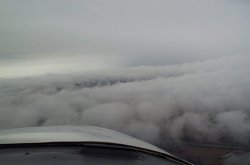 It started as a heavy overcast day with lots of fog. A buddy and I had just returned to Dallas on a commercial flight from Las Vegas and the weather was anything but cooperative. I was a reasonably new pilot (having had my license for just two years) and had never needed to fly in anything less than good weather. I knew at some point I would need to get an instrument rating but had not planned on getting socked in with fog.
It started as a heavy overcast day with lots of fog. A buddy and I had just returned to Dallas on a commercial flight from Las Vegas and the weather was anything but cooperative. I was a reasonably new pilot (having had my license for just two years) and had never needed to fly in anything less than good weather. I knew at some point I would need to get an instrument rating but had not planned on getting socked in with fog.
My buddy rented a car and drove home. I was stuck waiting for the weather to clear so I could fly back. It was not cooperating at all. Finally, after two days of fog, I had time to leave. The clouds finally lifted enough I could get VFR (visual flight rules) clearance.
IFR (Instrument Flight Rules) weather in Dallas was improving well, but I was headed in the same direction as the weather so it got worse before I got home. Now there were no storms along was just low clouds and fog.
The flight home from Dallas only took about two hours, but this was winter time and I didn't get to leave until mid afternoon. So, daylight became a precious commodity.
Normally daylight is not a problem. By this time I had flown at night many times and was used to it. But now, with the weather as it was, I needed as much light as I could get. As I got closer to home the clouds were lower, so I could not fly at an altitude I was comfortable with. It was down to 1500 ft (or less) and “scud running”....that's what we call it when your flying low just to stay below the clouds. It ain't fun.
Home At Last
Fortunately I was not flying a “high performance” plane and could fly low and slow. This was to my advantage. However, I knew having just a private pilot license was not enough as low clouds and fog are common in this part of the country. I needed an instrument rating.
Within the next two weeks I signed up for an instrument class in a neighboring town. Now, this six week class was already two weeks ahead of me so I had to really “dig-in” to finish. As I remember, it was interesting but there was a ton of information to learn. It all had to do with learning the lingo, legal stuff, and reading IFR (instrument flight rules) maps........which differed from what I was used to.
The second part of this training was in-flight training. Most of which was “under the hood”. Yes there is a blinder......called a hood.......that is used to screen out the outside world and make you focus on your instruments. It's supposed to simulate instrument conditions........does a good job of it too.
On a hot summer day, this can really zap the energy from you as you are rapidly learning new stuff and flying too. During this training, the one thing that really caught my attention is the way your senses can lead you astray but providing false information. A good example is maintaining a straight-and-level flight. When you have good visual cues like the ground and the surrounding horizon, flying straight and level is no problem. But, when you are in the clouds, you have no visual cues to work with and your sense of balance can get you into some serious trouble. Learning to disregard your senses and pay attention to the instruments takes time and training.
I finished my instrument rating in a matter of weeks and was now ready for any reasonably challenging weather.
